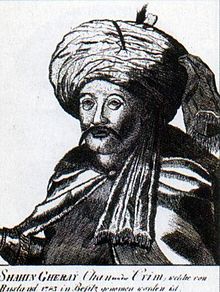| Şahin Giray | |
|---|---|
 | |
| Khan of Crimea | |
| 1st reign | 1777–1782 |
| Predecessor | Devlet IV Giray |
| Successor | Bahadır II Giray |
| 2nd reign | 1782–1783 |
| Predecessor | Bahadır II Giray |
| Born | 1745 Edirne, Rumelia Eyalet, Ottoman Empire |
| Died | 1787 Rhodes, Eyalet of the Archipelago, Ottoman Empire |
| Burial | |
| Dynasty | Giray dynasty |
| Father | Ahmed Giray |
| Mother | Saliha Sultan, a daughter of Ahmed III |
| Religion | Islam |
Şahin Giray, Shahin Khan Girai ( Crimean Tatar: شاهين كراى, romanized: Şahin Geray, 1745–1787) was the last Khan of Crimea on two occasions (1777–1782, 1782–1783).
Life
He was born in 1745 in Edirne. He was the son of Ahmed Giray and Saliha Sultan (daughter of Ahmed III) and he was the maternal great grandson of Mehmed IV and Gülnuş Sultan. He had a brother named Katti Giray. [1]
He studied in Greece and Venice. He reputedly spoke the Crimean Tatar language as well as Ottoman Turkish, Italian and Greek. When he was 20, his uncle Crimean Khan Qırım Giray called him back to the Crimea from his foreign school whereupon he was installed as the Commander of Nogai Horde. In 1770, the Russian Empire won a great battle against the Ottoman Empire and sought an alliance with the Crimean Khanate against the Turks. Selim Giray declined the proposal, precipitating a surprise attack by Russia against the Khanate. The Khan sent envoys to Saint Petersburg to sue for peace. During this mission, Catherine II met Şahin Giray and wrote of him:
"The Crimean Prince is the most gentle Tatar, I have ever seen. He's very talented, good-looking, and writes poetry. He wants to see and learn everything."
In 1776, Şahin Giray succeeded his uncle to become Khan of Crimea. [2] Sahin's rule was marked by upheaval. Russian expansion threatened the khanate from the 1730s up until the 1780s when they successfully seized the peninsula. [3] During his brief reign, he embarked on a program to re-build and modernise the Crimean Khanate. These reforms centred on the economy and government infrastructure, but included opening factories and moving the capital from Bakhchisaray to the important trade city of Caffa. Şahin Giray developed a fiscal policy that included the restructuring of taxation among Christians and non-Christians. He attempted to equalize taxes, however Christian taxation was much heavier than non-Christian people, ultimately leading to tensions between the clergy and Russia. [4] Militarily, Şahin Giray attempted to implement a new, more tolerant policy towards the Jewish and Christian minorities and integrating the two into the Muslim-majority military. However, his reforms were not well-received by the Nogai Tatar nobility or local aristocracy who both saw them as threatening their privileges and anti-Muslim, and by the common people who also saw this cross-religious integration as contradicting the laws of Islam. [5]
Sahin's westernization policies led to rebellion in 1777. He was only able to resume control in 1778 thanks to the assistance of Catherine II and the Russian military. [6] This turmoil turned into full civil war that led to Sahin's dethronement by the Russia's Catherine the Great in 1783. [7] Eventually, under enormous pressure from Russia and facing the inevitability of defeat, he agreed to a Russian offer to incorporate the Khanate into the Russian Empire. [8] As a result, he was compelled to move to Saint Petersburg, where he lived under house arrest. He appealed to be allowed to move to Edirne, where he had spent much of his childhood. In 1787, Russia and the Ottoman Empire agreed to allow him to move to Edirne. This move was not the retirement he was expecting because the Ottoman authorities saw him as a possible challenger to the imperial Ottoman throne. He was moved under arrest to Constantinople and then Rhodes where he was executed later that year under the order of the Ottoman sultan Abdul Hamid I.
Şahin Giray's family lived in Burgazada, Istanbul after his execution. [9]
See also
References
- ^ O’Neill, Kelly (2017-11-28). Claiming Crimea: A History of Catherine the Great's Southern Empire. Yale University Press. doi: 10.2307/j.ctt1wc7r72.7. ISBN 978-0-300-23150-2.
- ^ "SHAHIN GIRAY". www.osmanli700.gen.tr.
- ^ Teissier, Beatrice (2017). ""Crimean Tatars in Explorative and Travel Writing: 1782–1802."". Anatolian Studies (67): 231–53 – via JSTOR.
- ^ Kazemzadeh, Firuz (1971). "Review of The Russian Annexation of the Crimea, 1772-1783". The American Historical Review. 76 (2): 528–529. doi: 10.2307/1858782. ISSN 0002-8762.
- ^ Akhiezer, Golda (2023-06-07). "The Crimean Khan Şahin Giray (1777–1783): The First Modernizer of the Islamic World and his Image in Imperial and Minority Perspectives". Journal of the Economic and Social History of the Orient. 66 (5–6): 656–676. doi: 10.1163/15685209-12341603. ISSN 0022-4995.
- ^ O’Neill, Kelly (2017). Claiming Crimea: A History of Catherine the Great's Southern Empire. Yale University Press. doi: 10.2307/j.ctt1wc7r72.7. ISBN 978-0-300-21829-9.
- ^ Akhiezer, Golda (2023-06-07). "The Crimean Khan Şahin Giray (1777–1783): The First Modernizer of the Islamic World and his Image in Imperial and Minority Perspectives". Journal of the Economic and Social History of the Orient. 66 (5–6): 656–676. doi: 10.1163/15685209-12341603. ISSN 0022-4995.
- ^ An Empire of Others: Creating Ethnographic Knowledge in Imperial Russia and the USSR. Central European University Press. 2014. doi: 10.7829/j.ctt5hgzz6.15. ISBN 978-615-5225-76-5.
- ^ FERİDUN EMECEN, "ŞÂHİN GİRAY", TDV İslâm Ansiklopedisi, https://islamansiklopedisi.org.tr/sahin-giray (14.07.2020).
- LAST CRIMEAN KHAN in TR written by Leonid Bahrevskiy Translated from Turkish